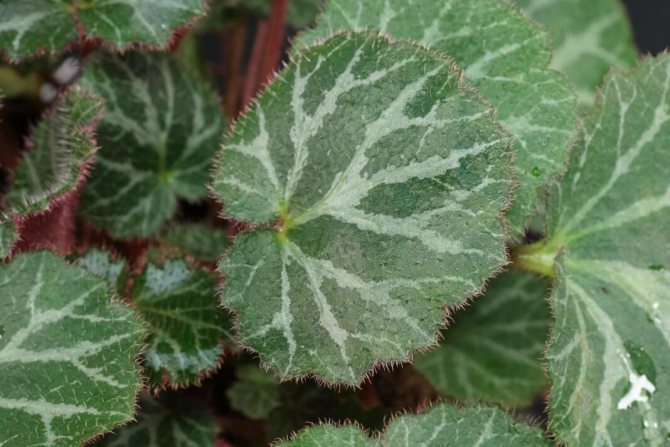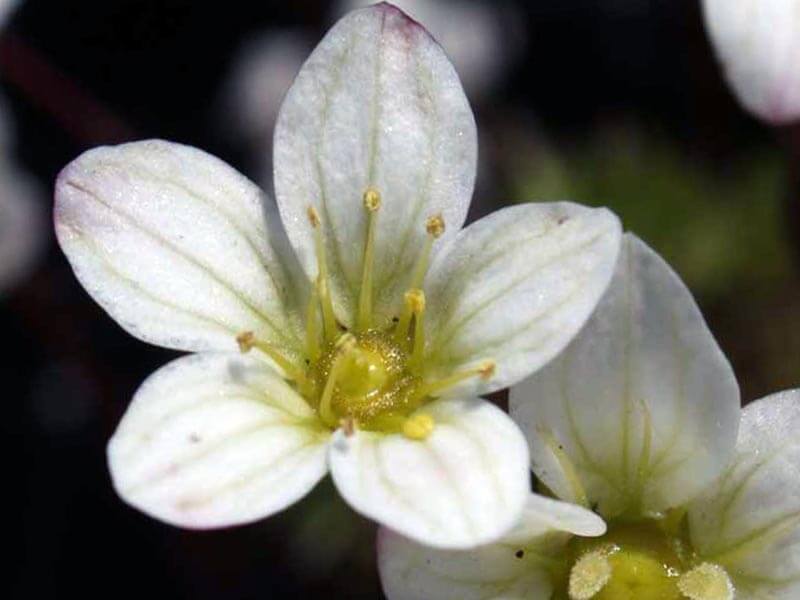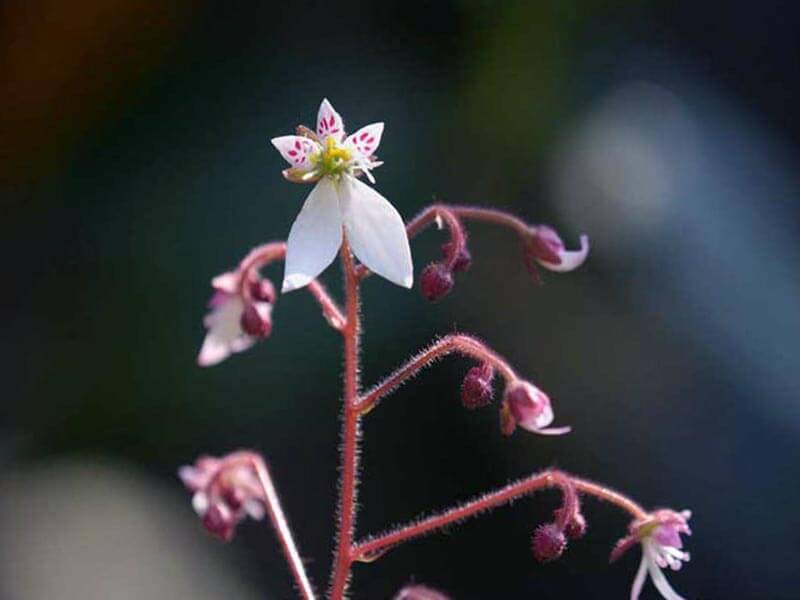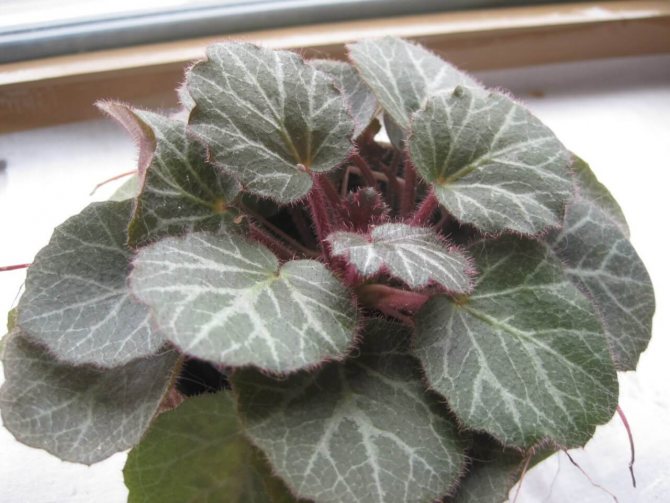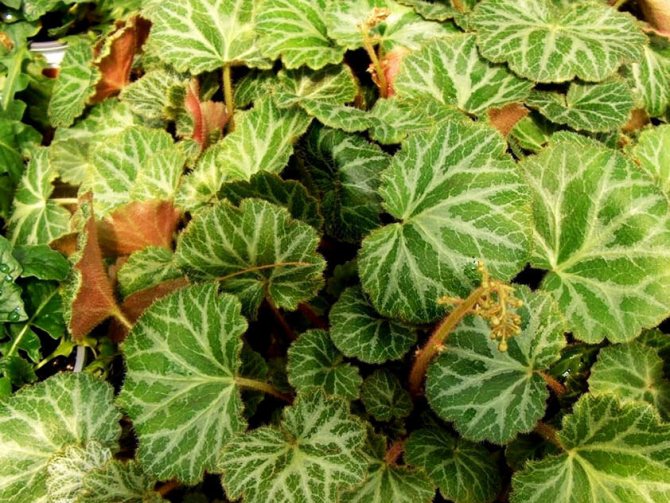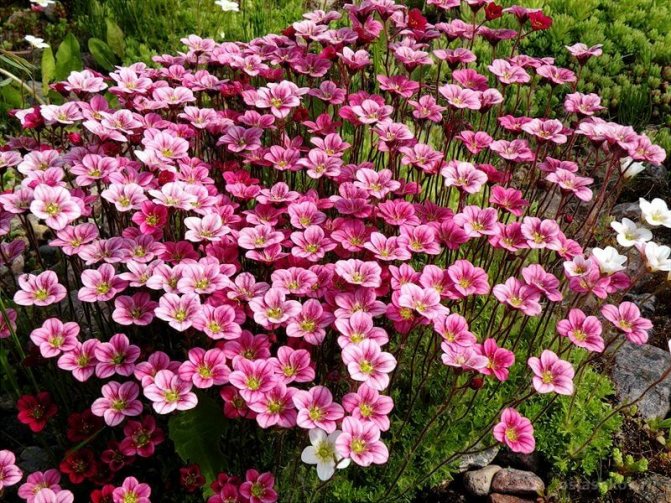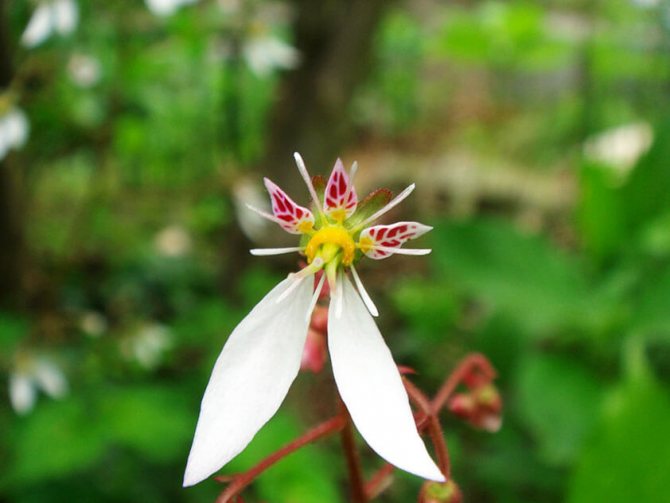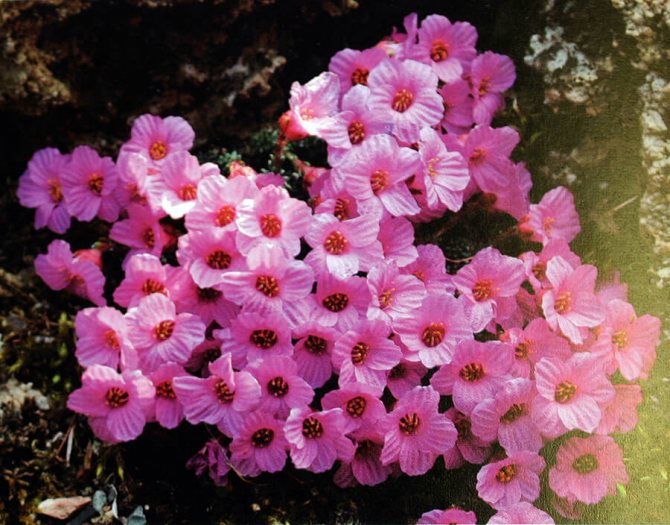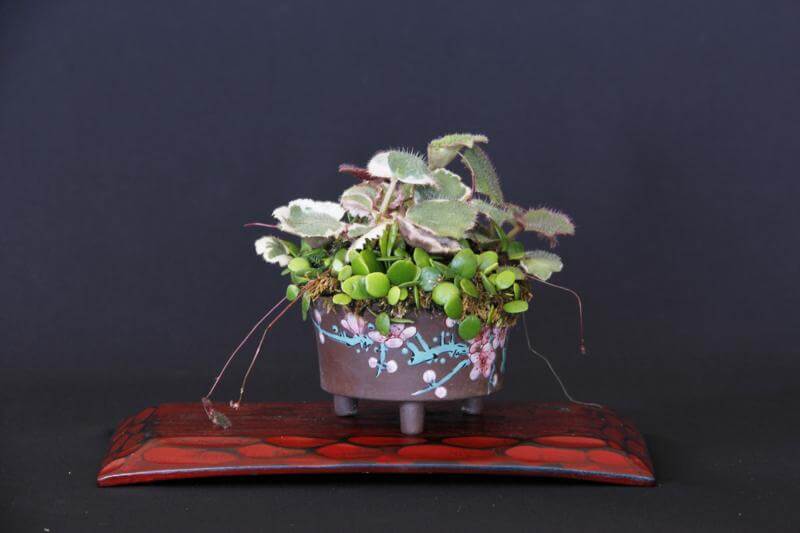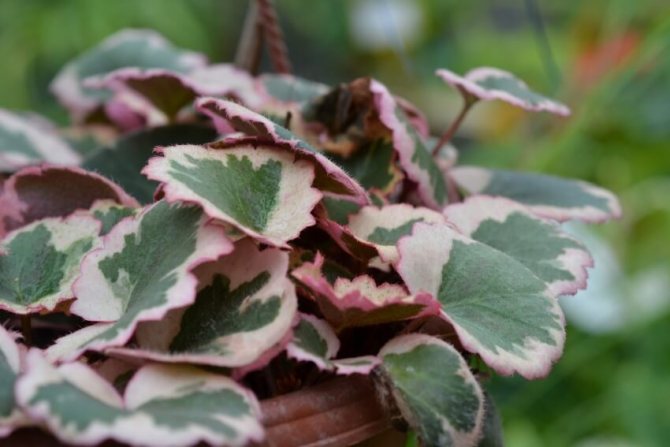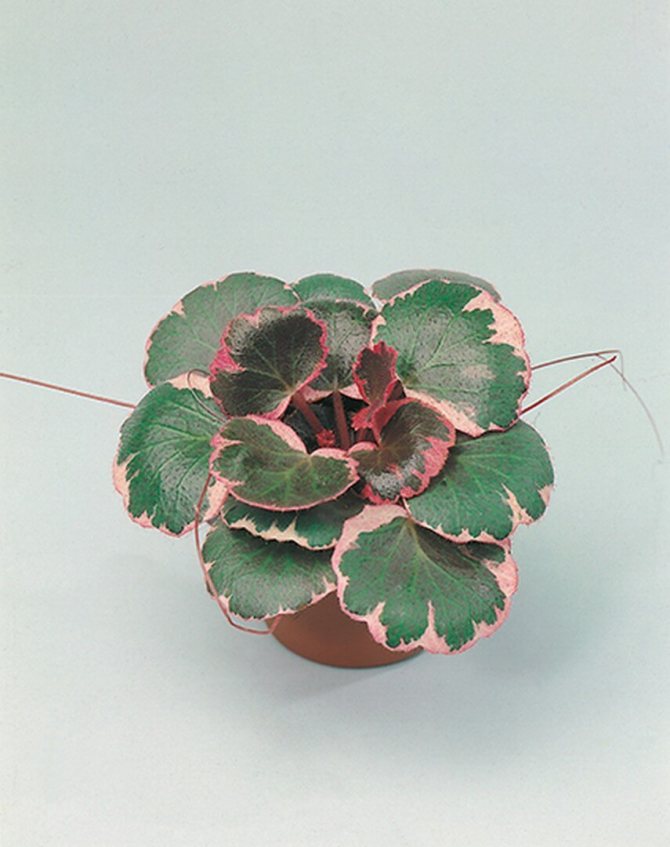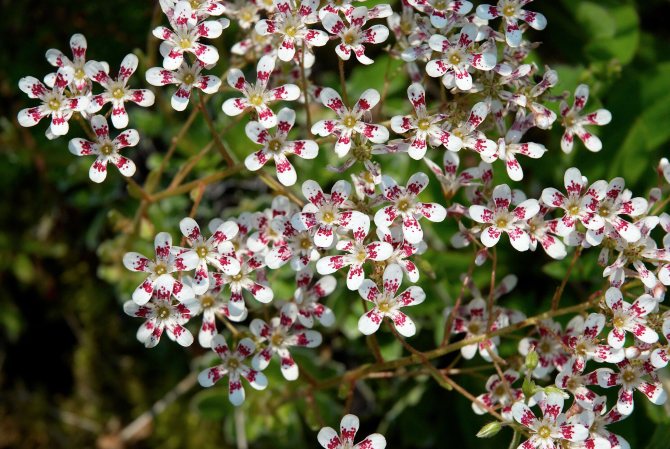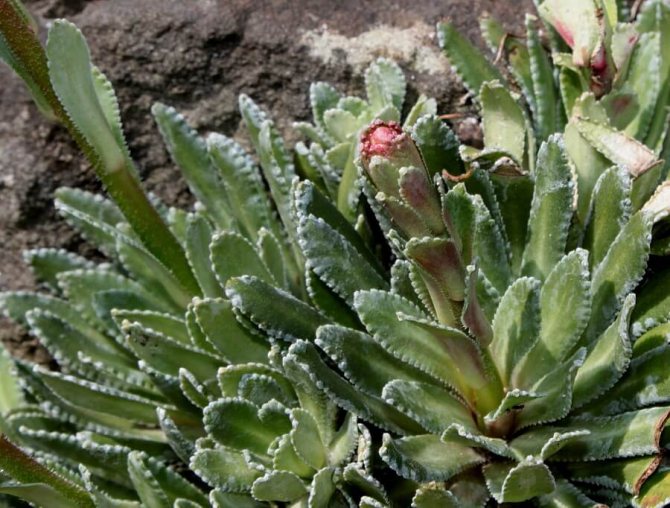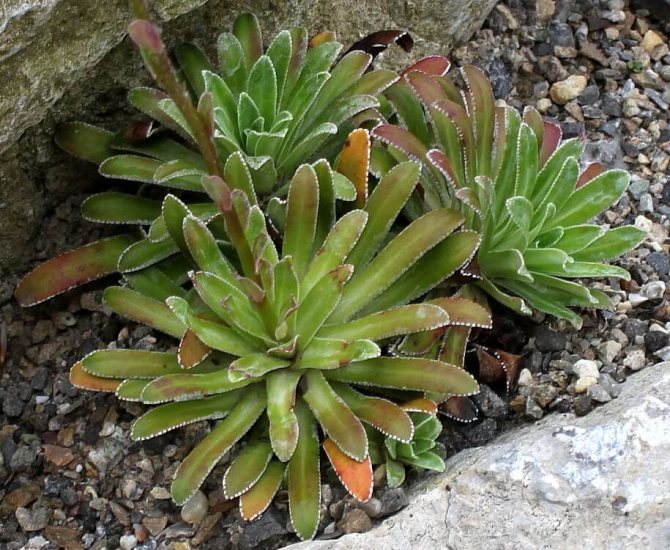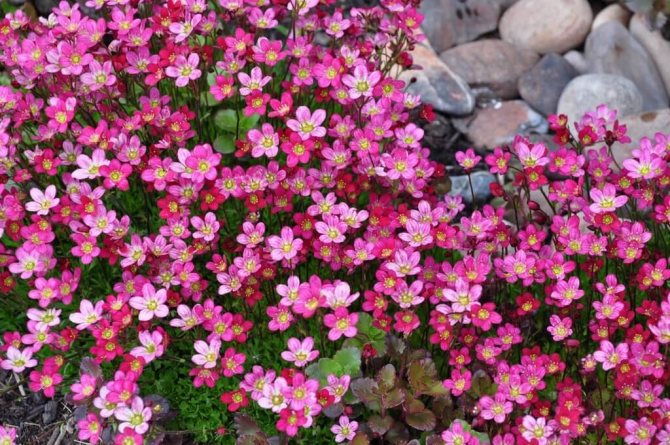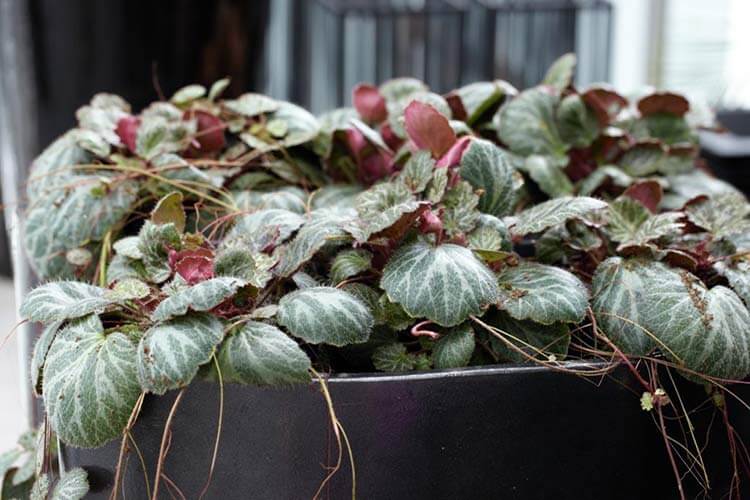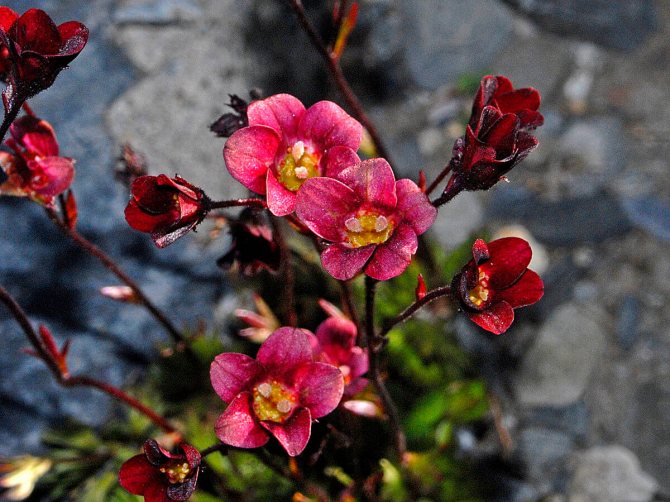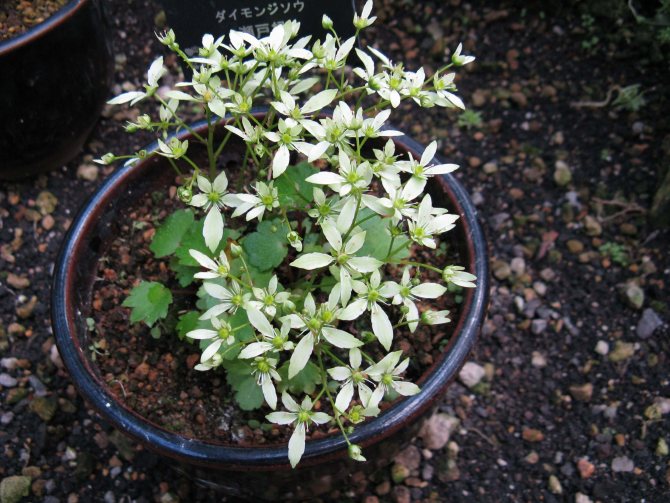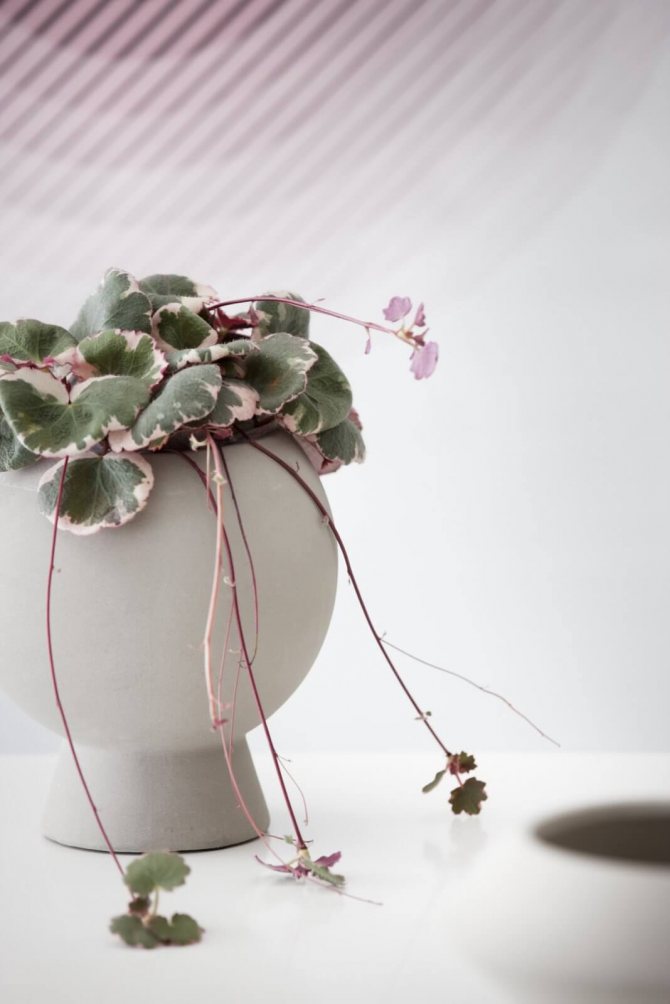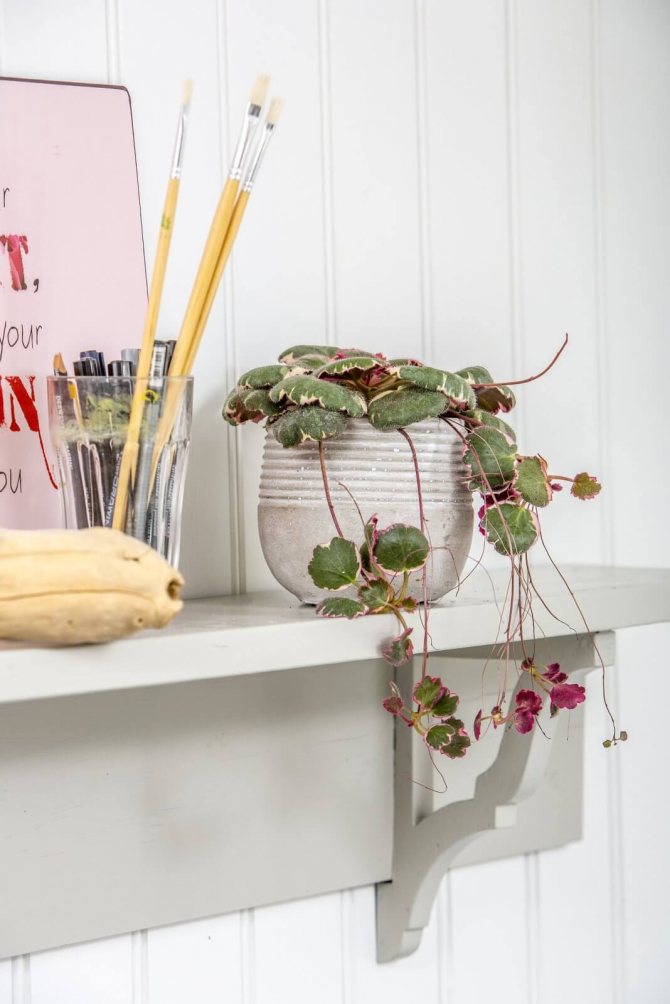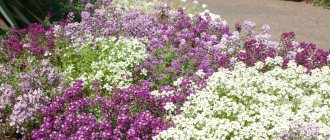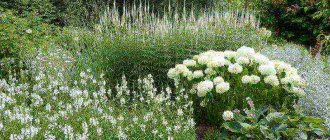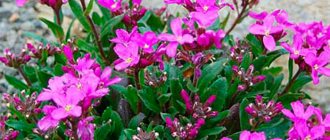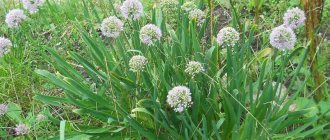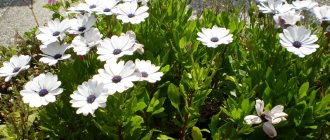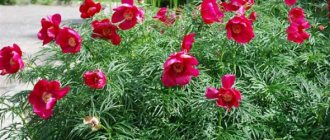Saxifrage is a herbaceous plant belonging to the Saxifrag family, belonging mainly to a perennial genus, occasionally one or two years old.
Saxifrage, which can be planted on poor soils, easily takes root in almost any conditions.
This is possible thanks to the powerful roots that the plant possesses.
The saxifrage got its name due to the fact that the root system can break through the stone. In the circles of amateur gardeners, this plant is called "tear-grass", for its ability to survive in incredible conditions.
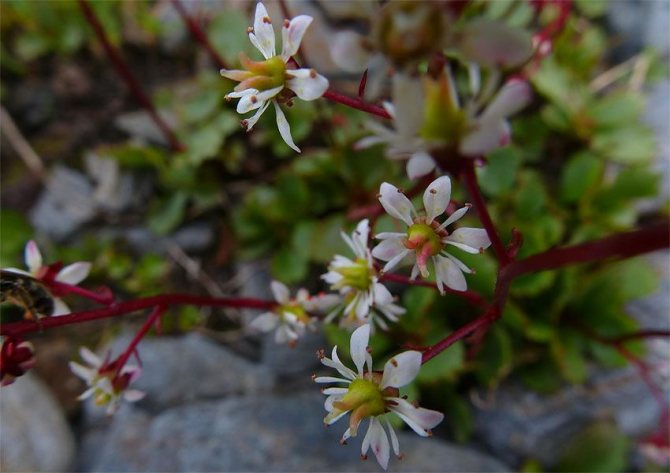
It is surprisingly resilient and can grow in very scarce natural resources. Saxifrage grows in Europe and Asia, found in the mountainous tropics of the African continent and Central America.
Photo gallery
Arends' saxifrage
Arends's saxifrage (Saxifraga x arendsii) is the most common species among florists. Rather, it is an interspecific hybrid belonging to the group of bryophyte saxifrage. Very pretty plant 10-20 cm in height, forms semicircular bright green pads. It blooms in late spring - early summer.
Arends' saxifrage. Photo from the site
During flowering, the entire curtain is covered with pink or white flowers on high pedicels. Winter-hardy and unpretentious species, it grows rather quickly under good conditions. He does not like drying out, with a lack of moisture, bald spots may appear, which over time themselves overgrow. Excessive moisture can cause partial fading. The care is undemanding, the main thing is to prevent the plants from drying out. Grown in an open place, but partial shade is acceptable. Prefers loose, moist soil. Plants need to be transplanted and rejuvenated no more than once every 4-5 years.
Interesting varieties:
- ‘Purpurmantel’. The flowers are purple-pink in color, the height of the plant is no more than 20 cm.
- ‘Blutenteppich’ has bright red flowers, the plant is undersized - up to 15 cm in height.
- ‘Schneeteppich’ - with white flowers, grows up to 20 cm.
- 'Flamingo' - pink flowers of an unusual shade, height 15-20 cm.
Arends' saxifrage in bloom. Photo from the site
Description of leaves, flowers and fruits of saxifrage
This is a beautiful decorative leafy herbaceous rosette plant. It has a rhizome, the roots of which are thin, branched, but at the same time fully provide nutrition for the entire flower. A feature of this plant is also the fact that roots can grow in internodes upon contact with the ground. This feature allows the saxifrage to grow rapidly over the surface.
The height of the home flower of the saxifrage is on average up to 30 cm. Some varieties of this plant can reach 70 cm, while others will not be more than 5 cm. The stems of the saxifrage are long, spread on the ground or hang down if grown in a pot.
Speaking of saxifrage, when describing this plant, it is impossible not to say about its foliage. Petiole leaves, gathering in a basal rosette. But depending on the type of plant, they can vary greatly in shape and shade. The fleshy foliage, depending on the type of saxifrage, can be almost round, oval, feathery, heart-like, etc. In one species it can be smooth, while in the other it is pubescent with fine hair.In some saxifrage, the leaves are green on top and bright red on the bottom, in others they can be bluish or gray-gray, up to 7 cm in diameter. On long, thin, filamentous stolon shoots, miniature daughter rosettes are formed.
A feature of saxifrage as a houseplant will be the formation of a white bloom on the foliage, which is especially clearly visible at the edges. This is a calcareous discharge that is produced by the plant itself.
Saxifrage blooms in early spring or early summer, on average, the peak occurs from May to August. The flowers are small, regular in shape, depending on the type, white-pink, or light yellow, collected in a complex brush or panicle, their size can reach 20 cm.
Look at the saxifrage plant in the photo during the flowering period:
General description of saxifrage
The saxifrage is presented in the form of a herbaceous perennial, the height of which ranges from 5 to 70 cm. The bushes are decorated with leaves of various shapes. It is appreciated by gardeners for the foliage of a dark green color with a blue, silver, bluish tint.
The flowers are medium-sized, five-petalled, regular star-shaped. There are solitary, but often collected in small inflorescences in the form of a panicle. Pleases with the long flowering of white, yellow, pink flowers.
The growing season begins in April, and in the second decade of May the plant begins to bloom, taking the form of a bright carpet. She wears this outfit for about a month.
Photo gallery
Each bud consists of 5 pointed petals, outwardly they resemble a bell with wide open edges or a star. The flowers of this plant give off a very light and pleasant aroma. The saxifrage is pollinated by insects or wind. The fruits are set in September and are boxes with seeds. The seed is small, dark, and its shape is oblong.
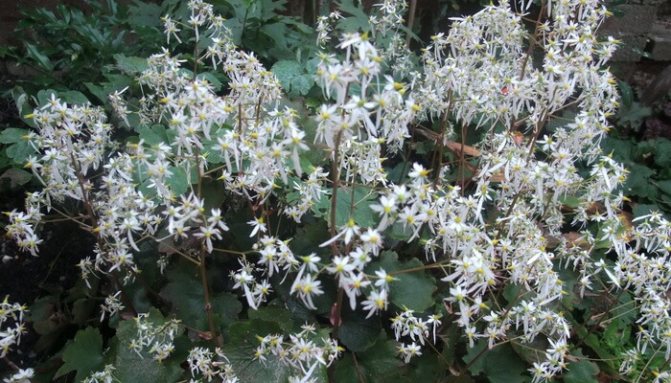

Saxifrage is good as an ampelous plant. It is often used not only for indoor growing, but also for decorating flower beds, alpine slides in the garden, as some of its species form a beautiful flowering carpet.
Benefit and harm
Application in medicine
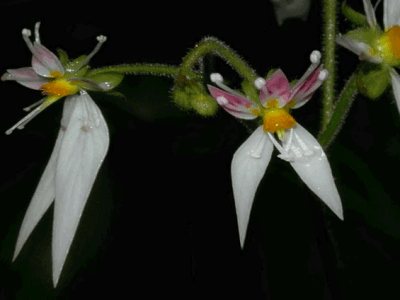

Saxifrage not only pleases the eye with its beauty, but also has remarkable healing properties.
Its leaves contain flavonoids, alkaloids, saponins, glycosides and other beneficial substances.
Folk healers have long noticed that this plant has an antitumor, antiseptic, anti-inflammatory and anti-febrile effect on the human body.
Saxifrage leaves are used to extract sap, which is applied externally with frostbite, boils or abscesses, as well as to reduce pain with otitis media. Internal use of this juice helps in the treatment of diseases such as ascites, bronchial asthma and nervous disorders.
Decoctions and infusions are prepared from saxifrage, which are used to lower the temperature, help stop vomiting and cure infectious diseases.
But, as you know, the misuse of any medicinal plant able to harm the human body. The use of saxifrage for medicinal purposes should be treated with caution during pregnancy and lactation. In addition, it is not recommended for people suffering from bradycardia and thrombosis.
Uncontrolled intake of this plant can lead to dermatitis.
Types and varieties of saxifrage: photos, names and descriptions of plant varieties
In nature, there are more than 400 species of saxifrage, many of them can be used for garden cultivation, for example, Bedrenets saxifrage, Soddy saxifrage and others. Check out the characteristics of some of them.
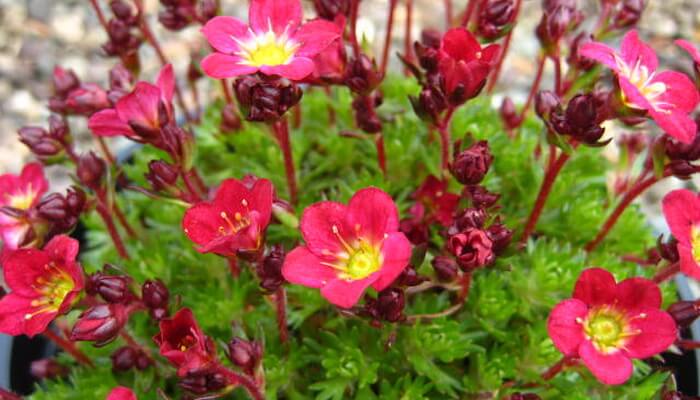

For home floriculture, species with medium-sized leaf rosettes are most often used.
The most popular is the braided saxifrage (S.stolonifera) and its varieties (you can see them in the photo):
Diseases and pests
The most common pest of saxifrage is spider mite. Excessive dryness of the air contributes to its appearance. The increased humidity of the air causes the appearance of fungal diseases and powdery mildew. Treatment of the plant will help to solve these problems. medicinal preparations.
Often the flower is attacked by worms, which must be harvested by hand. Anticoccidal drugs will help get rid of these pests.
If the leaves are covered with a black sticky bloom, it means that your pet has been damaged by a green aphid. In this case, process it pyrimor.
Photo gallery
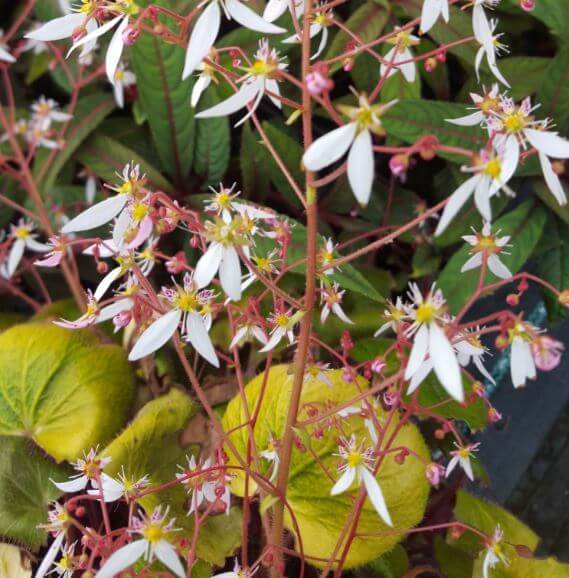

In nature, a plant of this species can be found in China and Japan. Usually several outlets are planted in one pot at once, then the flower looks more magnificent. The plant-bearing saxifrage grows in pots as an ampelous plant. Stolons grow from each planted bush, young rosettes are formed on them, from which side shoots appear again. The flowering period of this variety of indoor saxifrage is long, from May to September.
Harvest Moon saxifrage has a pale greenish tint of leaves that approaches yellow. Each sheet has a white and pink border around the edges.
The saxifrage variety "Tricolor" has a brighter color of greenery, look at the presented photo you can clearly see this:
Possible growing difficulties
The only difficulty that gardeners have when breeding saxifrage is the loss of decorativeness due to overgrowth. Since the regrown shoots are deprived of their leaves, which are located closer to the ground and the soil can be seen through them. Therefore, caring for the culture, attention must be paid to the renewal of the bushes and their division using cuttings. Also, so that the plant does not lose decorativeness, faded flowers need to be broken off along with the peduncle at the base of the turf.
Photo gallery
Another species that can be successfully grown at home is a hybrid of K. Arends mossy. This plant is an evergreen perennial with a taproot. As it grows in a pot, it forms a dense cushion of greenery about 12 cm in diameter.
Depending on the variety, Arends saxifrage produces flowers of different shades.
Look at the most common varieties of this saxifrage in the photo with names and a short description:
Saxifrage "Purple Carpet" - blooms with pink inflorescences.
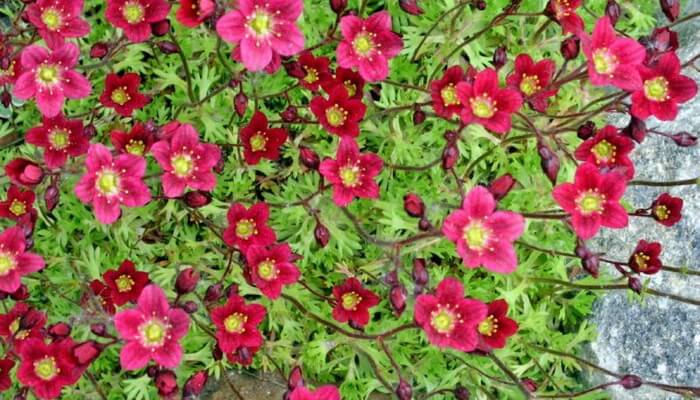

Saxifrage "Purpurteppich" - gives flowers of a red hue.
Saxifrage "Schneeteppich" - has white buds.


Saxifrage "Peter Pan" - will delight you with soft pink flowers.
Look at the saxifrage of the Cotyledon species in the photo, it is very similar in appearance to a succulent:
Popular varieties and varieties
The saxifrage family has 200 species. Of these, the following varieties are the most popular.
- Soddy saxifrage. The flower is a dense turf of rosettes with dissected leaves. Flowering is short, only 3-4 weeks, which is observed in June.
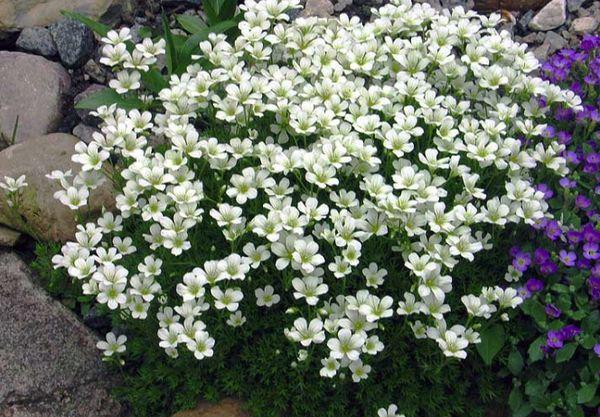

Gardeners prefer the following varieties:
- Rose-kenigen;
- Flamingo;
- Triumph;
- Purplemantel.
- Arends' saxifrage. The flower pleases with a bright green color during the season. Its foliage forms a continuous carpet, the height of which is up to 15 cm. It fascinates with its flowering in late spring. Among the common varieties of Anders:
- Sleeping Beauty;
- Red Cap;
- Peter Pan;
- Saxifrage;
- Snow carpet;
- Floral Carpet;
- Highlander.
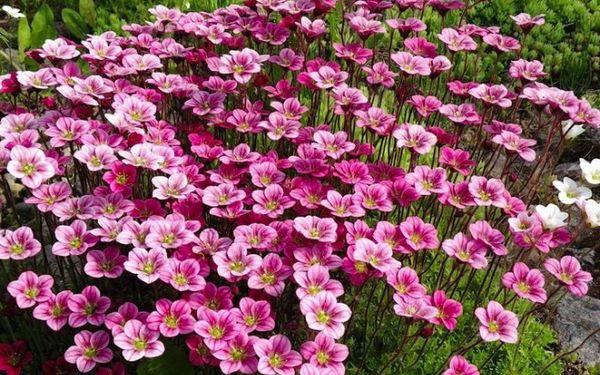

- Saxifrage paniculata. The flower is valued for its gray leaves, covered with white limescale teeth along the edge, as well as beautiful rosettes 5-6 cm in diameter. Pleases with flowering in June, July. The varieties that this species boasts:
- Macocha;
- Balcana minima.
- Wicker saxifrage.It has round, hairy green leaves with light stripes. Forms a rosette, from which many layering departs, which form new rosettes at the ends.
- Saxifrage is round-leaved. Bushes have petiolate leaves in the shape of a circle. In the first days of summer, white flowers are seen on arrows up to 40 cm long, the petals of which are decorated with purple dots.
- Saxifrage mossy. The bush is distinguished by creeping shoots covered with oblong green leaves. The edges of the leaf plate are cut into thin strips, which makes the dense pillow look like a thicket of moss. The plant is decorated with flowers of a yellow-white color up to 6 cm in length.
- Saxifrage shadow. A bush up to 20 cm in height has whole green leaves in the shape of an oval, which are covered with purple stains. In July, paniculate inflorescences begin to bloom, which are decorated with small white flowers. Their core is purple in color. The most common forms of shady saxifrage will be:
- Variegata;
- Aurapunctata;
- Elliotis Variet;
- Purple robe.
These varieties and varieties of saxifrage can improve the appearance of any area.
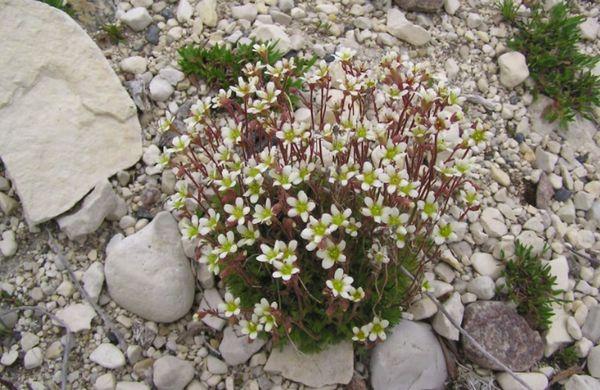

Photo gallery
The plant gives a rosette of dense foliage, depending on the varietal variety, it can be of a different shade. Its structure resembles a rose, therefore this species is often called "stone rose". When grown at home, it looks very impressive in a pot. During the flowering period, it releases a brush with many delicate buds on it.
The Arctic Fortchuna saxifrage of the Nadrezolopastny variety is especially popular for home cultivation. This type of flower, native to Sakhalin, the Kuriles and Japan, is a low-growing perennial plant with a medium-sized rhizome. The foliage is round, rather large, basal. It is located on the roots, and there are teeth at the edges. During the flowering period (from August to September), it gives paniculate inflorescences, on which there are many buds, the diameter of which can reach 1 cm.
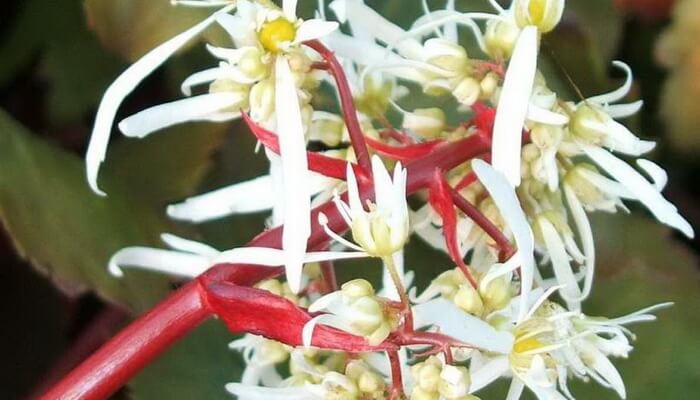

The "Fortune" saxifrage of the "Nadrezolopastny" variety has flowers of a pleasant pink hue.
Other varieties of this flower can also be distinguished:
Post-purchase actions
After the purchase, the saxifrage pot must be placed in partial shade. If the substrate is dry, it must be well moistened. Transplanting a plant into a new pot can be carried out no earlier than a week later. Moreover, not transshipment is carried out, but planting, with preliminary cleansing of the root system from the old substrate.
An important point is that before planting, to protect against diseases and ground pests, the rhizomes are soaked in a solution of a fungicide and an insecticide.
Photo gallery
Growing these subspecies is possible at home, but they are more suitable for garden decoration, as they produce an abundant green carpet with lush flowering.
Views from photo
Most often, saxifrage is grown in gardens and parks, but there are some species that take root well at home.
Wicker (Saxifraga stolonifera)
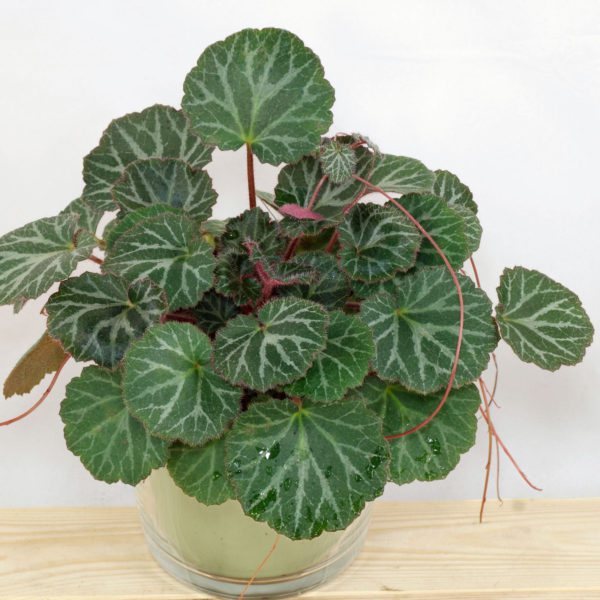

The plant is perennial. Leaves are long-petiolate, straight, concave or rounded, heart-shaped base. On the underside it is reddish, and on the outside it is green with white stripes. Shoots-stolons are long, thin, red in color. Rosettes are formed at the ends of the antennae. The flowers of the plant are small and inconspicuous, irregular, white or pink in color. Saxifrage blooms from May to September. Grows well in pots.
Cotyledon (Saxifraga cotyledon)
The leaf rosette is dense. The leaves themselves are petiolate, obovate or ligulate, their edges are finely serrated, covered with a white bloom. Flowers are star-shaped, numerous, pinkish-white. Flowering begins in May.
Arends (Saxifraga arendsii)
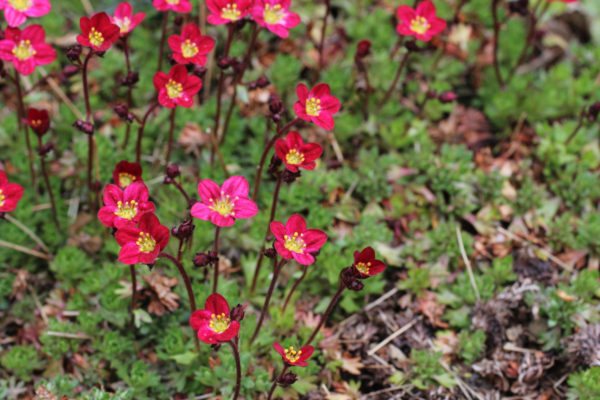

This hybrid has many varieties.Lobe-shaped leaves, glossy, deeply dissected, collected in rosettes. The flowers are of the correct shape, large in size, their color depends on the type of plant. The petals of the saxifrage are broadly oval in shape. They can be painted pink, yellow and white.
How to plant saxifrage and how to grow it (with video)
Saxifrage as an indoor flower belongs to light-loving plants. In such conditions, she feels very comfortable, but at the same time, she tolerates partial shade quite well. The most suitable location for a saxifrage would be a western or eastern window sill. But on the south side, the plant needs shading, for example, with a translucent curtain.
If you do not do this, then the foliage of the saxifrage will become pale. North windows are not suitable for this plant, as there will not be enough light for its normal development. In low light, the leaf veins of the saxifrage lose their brightness and the plant becomes not so variegated, and there can be no talk of a beautiful flowering.
In the summer months, growing conditions are suitable for saxifrage in the open air (balcony, veranda, loggia, pots can be taken out into the garden). But here, too, it is important to shade and protect the plant from possible precipitation.
In winter, the minimum temperature is 5-7 ° C, but even here a lot depends on the type of saxifrage. For example, owners of variegated leaves in winter require a higher temperature (within 16 ° C), and plants with green foliage do well at 12-14 ° C. In the summer, this indoor flower will develop well at 20-25 ° C.
Another factor for saxifrage to consider when nursing and growing is good air circulation. Remember that the room where the pot with this indoor flower is located should be regularly ventilated.
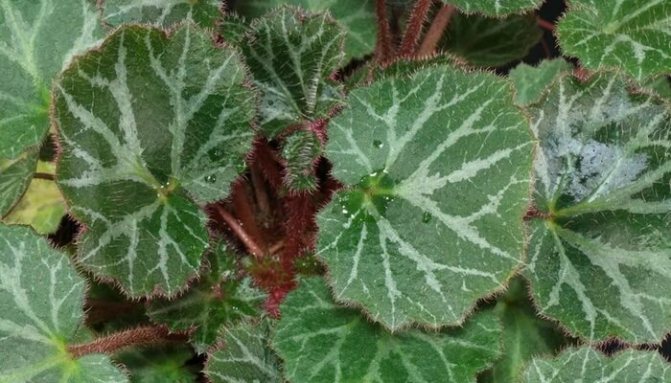

The plant requires high humidity, and every other day it is sprayed with water. You can increase this indicator during the heating season or on hot summer days using a pallet with gravel or expanded clay, which should be constantly moistened. A flower pot is placed on such a structure. In this case, make sure that the holes on the bottom of the container do not touch the water in the sump, but are located on the drain. This will protect your plant from excess moisture in the potting soil. During the heating season, you can place a damp cloth on a warm battery - this is another way to increase the percentage of air humidity.
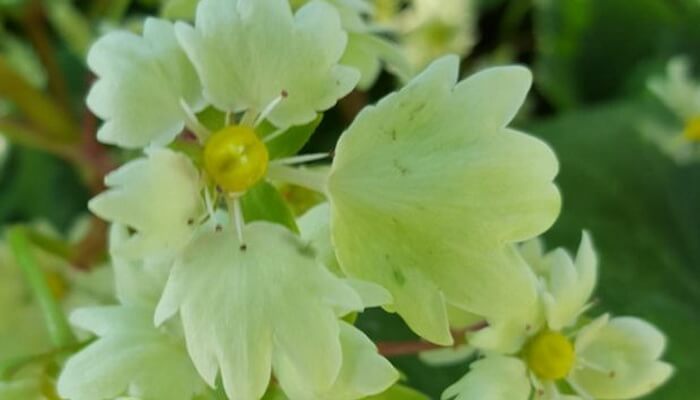

Before planting the saxifrage in the ground, it should be disinfected. To do this, it is enough to hold the soil in a well-heated oven for about a quarter of an hour. The substrate - humus, leafy and soddy soil, sand (1: 1: 1: 1) is suitable for almost all types and varieties of saxifrage, but for K. Cotiledon, a more acidic soil should be selected. Another important point to the choice of soil mixture is to give preference to soil with good air and moisture permeability.
For more information on environmental requirements for saxifrage, see this video:
When caring for this plant, certain rules should be remembered. Even though it grows in the wild in a rather harsh climate and conditions, hybrid species for growing at home require special attention. Therefore, if you want the indoor saxifrage to develop well, provide it with decent care.
The main things to pay attention to when growing this plant:
- Watering.
- Maintaining moisture.
- Fertilization.
- Transplanting and soil preparation.
Watering should be plentiful in summer, moderate in winter. Despite the fact that the plant belongs to the moisture-loving plant, the saxifrage, when taken care of at home, will not tolerate stagnation of moisture in the soil. This leads to decay of the root system and the death of the flower. As well as stagnation of moisture, one should beware of prolonged complete drying out of the soil in a pot with saxifrage.Therefore, gardeners recommend orienting themselves to determine the time of moisturizing on the top layer in the pot. As soon as it dries out 2-3 cm deep, it's time to water it.
When humidifying, use soft room temperature water and make sure that it does not fall on the rosette of leaves. Moisture in this area can lead to decay. To keep the plant safe from water entering the outlet, you can use bottom watering. To do this, liquid is poured into the pallet, and as soon as the earth is completely saturated with moisture, the remaining is drained.
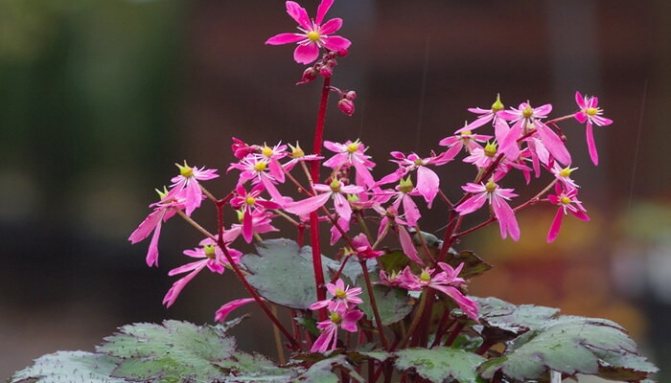

The saxifrage plant, when leaving in the summer, requires mandatory spraying. It should also be carried out regularly in winter, provided that the room where the flower grows is dry air. Spraying is carried out every other day from a spray bottle, and warm, soft water is used for this procedure. Spraying should be very fine and carried out around the plant pot so that drops do not run into the outlet.
The specifics of growing flowers
In order for the saxifrage to attract attention with its high decorativeness, it is necessary to properly plant. This procedure will not cause difficulties even for novice gardeners. The secret to successfully growing saxifrage is to create conditions as close as possible to its natural habitat.
See also
Preparing geyhera for winter, types of shelters, pruning and care in springRead
Time and place
Saxifrage is not a capricious culture, but when determining the landing site, it is important to take into account its natural preferences. When placing a flower garden, you need to know that the flower loves shady places where it is protected from the scorching sun. Ideally, trees and shrubs will grow nearby.
An important factor in the cultivation of saxifrage is good drainage. Stagnant water can be detrimental to flowers, so you need to consider in advance where the perennial will grow. A good solution would be to plant a flower in crevices between stones or on a slope, while additionally watering during the dry season.
Saxifrage seedlings are advised to be planted in June, when the air and soil will have a temperature of 18-20 degrees.
Soil preparation
Saxifrage takes root without problems on soils of medium fertility. But since it needs limestone, it is better to enrich the soil with crushed limestone. The ideal soil for a crop should be equipped with substances such as gravel, clay, sand, peat, humus. Also, soil preparation includes the addition of superphosphates along with organic matter. It is recommended to lay out a rock garden near the bushes, using stones, this will protect the roots from the sun and retain moisture.
Before planting, dig up the soil, loosen it, remove large stones. The day before planting seedlings, moderate watering of the future flower bed.
Planting instructions
To plant a plant, you need to adhere to the following procedure:
- Make holes at a distance of 10 cm.
- Place the seedlings in the center of the hole.
- Fill in the soil around the stem and tamp a little.
- Drizzle over the edge of the hole.
Will delight the flowering saxifrage after a year. In one place, a ground cover plant can grow for 5-6 years, then it needs to be transplanted.
How to care for saxifrage: feeding and transplanting
During the period of active growth (March - August), complex fertilizer is applied weekly. In winter, the amount of dressing is reduced to once every two months. Timely fertilization is the answer to the question of how to grow a beautiful, regular saxifrage. If the feeding is not enough, then the shoots of the plant stretch out, the rosettes practically do not develop, and the flowering period may not come. It is important to remember that if you use fertilizers for decorative leafy houseplants, which is also acceptable for saxifrage, then the concentration indicated on the package for it should be halved.
Transplanted annually in the spring while the plant is still young.How to care for a room saxifrage when it is already old enough? For such flowers, the transplant is carried out as needed, paying attention to the root system. If it has completely occupied all the soil, it makes sense to transfer to a larger pot. For such a plant, it is necessary to select a low but wide capacity. And to make this indoor flower look more magnificent and impressive in it, you can plant several outlets in one pot.
Saxifrage care
In order for flowers to attract attention with their decorativeness, you need to surround them with care.
Soil and fertilizers
Feed plants only with formulations containing minerals. Fertilize for the first time after 7 days, then 2 times a month. Nutrients should be added to the water when watering. At the time of flowering and in winter, stop feeding.
Watering and humidity
Saxifrage requires moderately moist soil. When the soil dries up, the flower will die, therefore, in dry weather, it is recommended to spray the leaves. This will give the saxifrage a spectacular look.
Wintering
The saxifrage is characterized by resistance to frost, but young immature specimens of rare varieties are best covered for the winter. To do this, in the fall, before the first frosts, plantings must be covered using dry foliage or spruce branches.
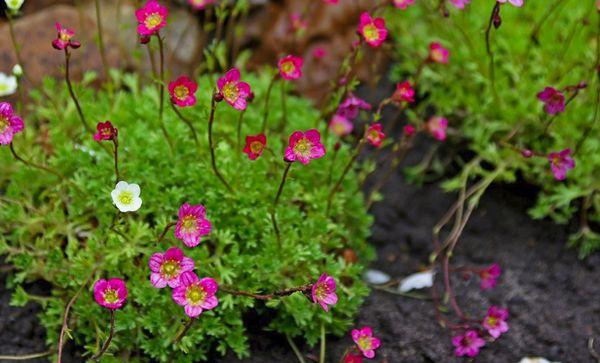

Reproduction of saxifrage: how to plant a daughter outlet
Saxifrage is a plant that reproduces by means of daughter rosettes with aerial roots that form at the ends of shoots, by dividing a bush or by seeds. The first method is considered the simplest and most affordable, which even novice gardeners can handle.
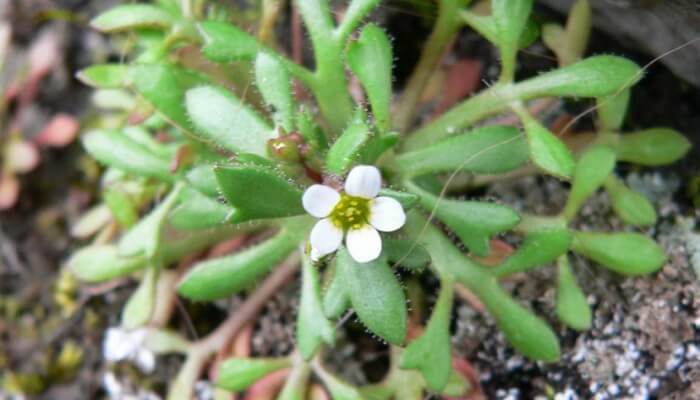

This can be done in two ways:
- Plucking daughter sockets.
- By planting them in the ground without separating from the mother plant.
How to plant a saxifrage daughter rosette by plucking? To begin with, you should choose a suitable healthy shoot. At its end there should already be a formed rosette; in some varieties, small roots can already be seen on it. It is carefully separated from the shoot with a sharp blade. The rosette deepens into the prepared soil to a depth of 2-3 cm. The soil in the pot must be moistened, but not flooded. Very soon, such an outgrowth will take root and begin to grow actively. The first fertilization should not be earlier than 1 month after planting.
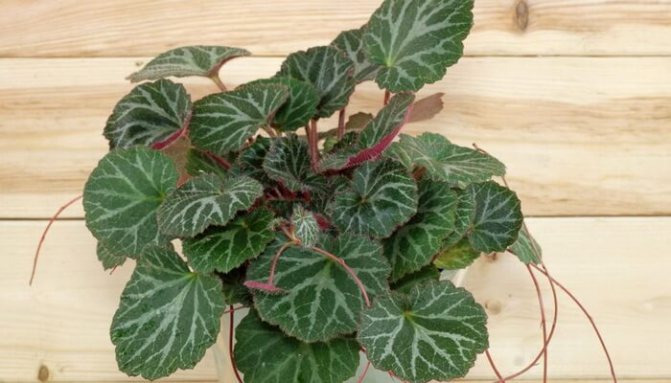

If no roots are visible on the outlet you have separated, then such planting material must be held in water with "Kornevin" before planting in the ground. As soon as the roots appear, feel free to plant the plant in the ground.
Another way to plant a rosette without roots is to place it in the ground, without separating it from the mother plant. A saxifrage flower with such a planting and proper care (timely watering, temperature in the range of 20-25 ° C) will take root very quickly. As soon as signs of development and growth of a young plant appear, it is separated by cutting off the stolon.
Possible difficulties
With excessive dampness and stagnant water, saxifrage is affected by powdery mildew and rust. Mildew stains can also appear on the leaves. To prevent such diseases, it is necessary to keep plants in a drier room and limit watering. Damaged leaves and shoots are cut off, and the remaining parts are treated with "copper sulfate" or fungicides.
Sometimes spider mites, worms and aphids settle in the thickets. They quickly disappear after treatment with an insecticide (Aktara, Pirimor) or soapy water.
Proper cultivation of saxifrage from seeds and home care
But it is not so easy to grow a saxifrage from seeds at home, and such a procedure requires a lot of patience and effort from a grower. Sowing of planting material is carried out in the spring.To begin with, boxes are prepared, which are filled with vermiculite and peat in equal proportions, the earthen mixture is well pressed. Seeds mixed with sand are planted on the prepared soil, but they are not sprinkled. For saxifrage when grown from seeds, moisture from a spray bottle is sufficient. Next, the container with the planting material is covered with polyethylene, creating optimal conditions for growth. The maintenance of the box with saxifrage seeds should be carried out at a temperature in the range of 18-22 ° C. Under such conditions, the first borings will appear during the crescent.
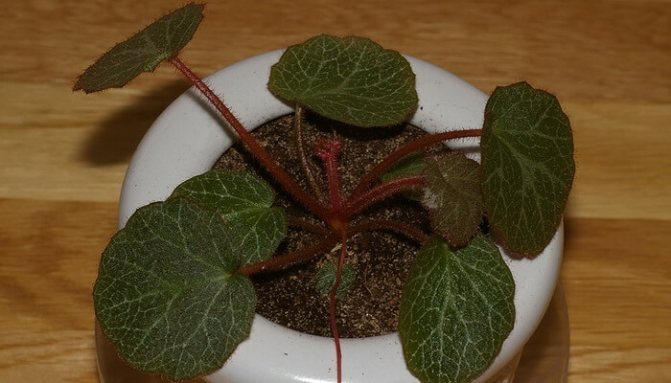

The picking of seedlings is carried out after the appearance of 2-3 full-fledged leaves. To do this, each bore is transplanted into separate medium-sized pots. Here, a room saxifrage, grown from seeds, will stay until its root system completely fills the allotted container. During this period, the sprouts need to provide the conditions described above. Further, the formed young plants can be planted in several pieces in one pot, but it must be wide enough for such a planting. The first color of a saxifrage, when properly grown from seeds at home, will give next year.
Reproduction
The most popular breeding methods for saxifrage are as follows:
Seeds
Seeds are recommended to be sown in seedling boxes in spring. Growing saxifrage from seeds is a pretty fun process. It is not worth planting them in open ground right away, since they are very small.
IMPORTANT! To increase the germination of seeds, they are kept in the cold for two months.
The seeds are mixed with sand and sown in boxes filled with a light nutrient medium consisting of greenhouse soil, sand and peat.
Nothing from above you do not need to sprinkle the seeds. Water them with a spray bottle and keep them in a room where the air temperature is between eighteen and twenty degrees Celsius.
Already on the sixth or ninth day, you can notice that the seeds have sprouted. Then you will need dive shoots, leaving the strongest of them. When the seedlings grow up, they can be planted in pots or placed in open ground.
For more information on growing saxifrage from seeds, see the video:
Outlets
To propagate a plant with rosettes, you need to cut off one of the side rosettes that form on your pet as it grows. The best way to do it in summer time.
Dig in its base with soil and water it. When the rosette takes root, let it winter in the same place, and you can transplant it next spring.
Shoots
For the propagation of saxifrage by shoots, it is necessary to bend the extreme long shoots to the ground and sprinkle them with moistened earth so that the top remains on the surface. Cover the dug-in place with humus and foliage to protect the soil from drying out.
When the shoot takes root, separate it and plant it in a substrate consisting of a mixture of two parts of humus soil, one part of sand and one part of turf soil. After planting, the shoot needs abundant watering.
Dividing the saxifrage bush
The method of reproduction by dividing the bush is used more for plant rejuvenation. After the flowering period is over, young rosettes with roots are separated from the center of the mother bush and planted in a prepared soil mixture. Pots with such young saxifrage should be kept in a shaded place, since they are rather weak, then, when they begin to actively grow, you should choose a place with brighter lighting, but without direct sunlight.
Look again at the various types of saxifrage in the photo and remember their names: Plentosnaya, Arends, Fortune:
Planting and transplanting
The transplant is carried out not according to the schedule, but as the roots of the plant grow. As soon as they braid the earthen ball and the container becomes cramped, they carry out the transplant procedure.A new pot is selected shallow.
Reference! If the transplanting process occurs at the time of flowering, then in this case, the peduncles must be cut off.
The procedure consists of the following steps:
- A drainage layer of expanded clay or sea pebbles is laid at the bottom of the pot. A little soil is poured on top.
- The plant is removed from the pot, lightly shaken off from the earthen coma, the roots are examined, and if rotten and damaged are found, they are removed.
- The saxifrage is placed in a new flowerpot. The voids are filled with soil and moistened.
After transplantation, moisten, and the first feeding is carried out after 2 weeks.
Photo gallery
Such plants can become a real decoration of your windowsill, and with proper care they will surely delight you with abundant and beautiful flowering.
Breeding methods
Reproduction of saxifrage is not difficult. Can be grown by dividing the bush, rooting outlets, or sowing seeds.
Seeds
Saxifrage seeds are highly germinating. After sowing, they germinate within a week, but before that they must undergo stratification. When sowing, the seeds are scattered over the surface of the soil and slightly pressed down. After careful spraying, the container with seeds is covered with foil and placed in a warm place. For germination, it is necessary to maintain the temperature from +18 C to +20 C degrees.
Shoots
When the plant has faded, reproduction can be carried out by dividing the bush. The rosettes are carefully separated by hands from the mother plant. Then they are rooted in the shade, like independent seedlings. It is imperative to protect young seedlings from direct sunlight.
Outlets
The most effective breeding method is by rooting outlets. We put small pots with a substrate or small cassettes - up to 10 cells near the flowerpot with a saxifrage. We place the sockets in the center of the pots and pin them to the ground. Then the soil is poured abundantly, and then regularly sprayed, until rooting. After regrowth of the roots, the whiskers coming from the mother plant are cut off.
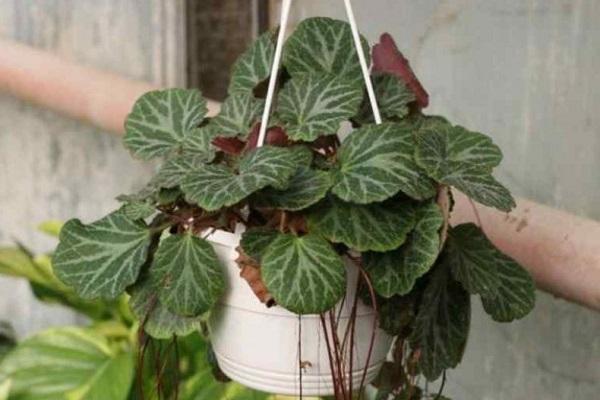

Possible problems in growing saxifrage
This bush is resistant to diseases and parasites, but the health of the flower can be shaken due to the violation of the conditions of maintenance and vital activity of pests.
Changes in appearance
Yellow, dry and deformed lower leaves indicate the old age of the plant, in this case it is time to carry out the renewal procedure.
The lack of branching and layering may indicate a lack of nutrients, which can be easily replenished with a quick-acting liquid top dressing or a universal top dressing capsule placed 3-5 cm deep into the soil.
The fading and looseness of the bush can be observed both with a lack of lighting and with overheating - in this case, it is necessary to urgently change the location of the pot.
Additional Information. As a preventive measure, it is useful to take care of the leaves, wiping with warm water from dust once a month.
Frequent illnesses
- Excess moisture can lead to decay of the root system. When wilting and blackening, the plant should be examined for decaying roots. They are removed along with the affected leaves. The remaining petioles can be rooted in a temporary sand substrate with 50/50 pieces of sphagnum. A greenhouse effect is created, the pot is placed in a place with the recommended temperature and sufficient lighting. The saxifrage can release its first sprout within a month.
- Rust infestation occurs through insect-borne fungal spores, with grainy spots of the corresponding color indicating that the water balance is imbalanced. Rust is treated by removing the affected areas and applying a fungicide, which is repeated 10 days later. In this case, the plant should be protected from the presence of conifers.
- Powdery mildew is the result of a fungus, white spots on the lower leaves with time of maturation of the spores are replaced by drops of moisture. This stops the flower from growing and makes it vulnerable to cold.Damaged shoots should be separated and burned, and the plant itself should be treated with fungicides such as Quadris or Skor.
Main parasites
- Infection with a spider mite is manifested in the dryness of the saxifrage. The leaves turn yellow, and a light cobweb appears on their bases. This is treated by removing and burning the affected areas, then applying an insecticide.
- The sticky white bloom on the leaves is the secretions of aphids, the flower is washed with soap and regularly sprayed with a settled composition of garlic, pyrethrum, onion peel and pepper.
- The inflorescences and foliage of the plant attract worms; they multiply quickly when the flower lacks moisture. Symptoms are a sugar-like discharge. Worms are treated by treating the affected areas with a composition of 12 g of soap per liter of water once a week and hand-picking the pests. In the future, the saxifrage must be treated with biotlin or confidor.
Additional Information. In addition to these pests, the flower can be infested with thrips and nematodes.
The beauty of the plant deteriorates if the conditions of maintenance are not observed during the cultivation process, which entails uneven stems and bald spots in the usually tight branching cover. Open ground can attract birds and mice to the flower.
In general, growing saxifrage is not difficult, and the wide variety of species opens up good scope for decorating a room or garden area. For inexperienced gardeners, the plant is quite suitable.
Shade Saxifrage Flower Carpet
Saxifraga Umbrosa Flower refers to the shade-loving varieties of this plant. Shadow saxifrage is a whole-leaved evergreen perennial that forms thickets reaching a height of 20 cm.
Its leaves are distinguished by uneven edges and have an oval shape, they are spatulate, shiny, dark green, purple below, resistant to cold.
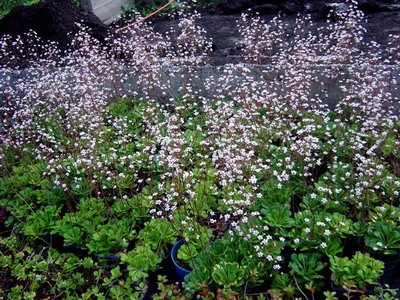

The flowering period occurs in mid-summer, the plant blooms with flower rosettes that rise on low peduncles up to 25 cm long. The flowers are small, white at the edges, and purple in the center.
In addition to peduncles, short recumbent shoots, called stolons, also grow from the center of the rosette. They reach a length of 5-10 cm and at their ends have the rudiments of future rosettes. Stolon shoots live only one year, because in winter they simply die off like a strawberry mustache.
This type of plant is capable of forming very dense and dense thickets formed from many rosettes. However, the growth of the saxifrage flower carpet grows very slowly, therefore, the cover formed by the rosettes of this flower very often consists of clumps separated from each other.
This flower looks especially good and grows under trees and among tall bushes, for example, among geraniums. The flower tolerates shade well, reproduction occurs vegetatively.
Arends' white saxifrage mossy: "Purple Carpet" and other varieties
This is a garden bryophyte hybrid, evergreen taproot, perennial, forming a dense leaf cushion about 10-15 cm high. The flower looks very beautiful and resembles soft "pillows" in its appearance.
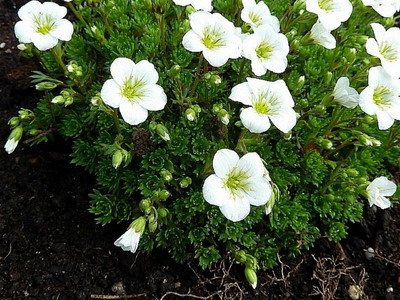

The plant is distinguished by three or five lobed light green leaves and beautiful small white flowers. They are collected in loose clusters of 5-9 flowers each. White saxifrage blooms especially abundantly in May – June, propagates by cuttings in June – July and seeds for seedlings.
The most popular varieties of this hybrid are saxifrage:
How to plant in open ground saxifrage
Saxifrage is planted in open ground in early spring.
You can plant the saxifrage with seeds directly in the open ground. Then they will not need stratification, they will go through it in natural conditions. Sowing is done in early spring, most often in April. Not all seeds will sprout. If seedlings do not appear in 2-3 weeks, then the flower will not grow at all.
Seedlings are planted in prepared soil.To create conditions close to natural, lime, gravel, peat and sand can be added to it. The distance between plantings can be no more than 20 cm so that the flowers grow in a solid carpet.
Types of saxifrage: photo
Care
Saxifrage is a flower that can be called one of the most unpretentious plants. A native of the mountains, she is distinguished by its endurance, longevity and is not afraid of frost. Nevertheless, there are a number of conditions under which a plant develops best and shows itself in all its glory. These include moderate watering without waterlogging, correct soil composition, adequate lighting with light shading, and regular fertilizing with a mineral complex.
IMPORTANT! Adult saxifrage do not require shelter for the winter, while young bushes should be insulated to protect them from severe frosts.
In an apartment, the plant feels good. He is pleased with the low humidity and coolness. But the main difficulty in keeping Saxifrage in a pot is maintaining the correct watering regime. The fact is that this representative of the flora is not able to independently cope with the excess amount of moisture in the soil.
From waterlogging, its roots quickly rot, as a result of which the green pet may die. Therefore, moderation in watering is extremely important for saxifrage.
About caring for a room Saxifrage is written in this article.
NOTE to other plants, which are also popular with flower growers due to their unpretentiousness. For example, the tropical plant Cordilina straight, the exotic flower Cotyledon, Setcreasia Violet, the "dollar tree" Zamioculcas, and the evergreen plant Pizonia.
Photo
See further photos of Saxifrage flowers:
Saxifrage purple (Saxifraga purpurascen)
A flower such as purple saxifrage or Saxifraga purpurascen is very popular in the middle lane.
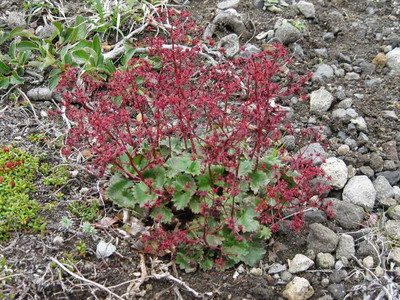

It is a summer-green herbaceous perennial with a short-rhizome-brush-root structure and erect rosette shoots. It reaches a height of 25 cm and has a pronounced anthocyanin coloration of petioles and stems.
The leaf blade of plants is reniform, almost round, reaching a diameter of 4 cm, along the edge it is crenate. The stem of the plant is leafless, the inflorescence consists of crimson flowers and is a spreading panicle.
The flowering period of the plant falls in June-July, the capsule fruits appear in August-September.
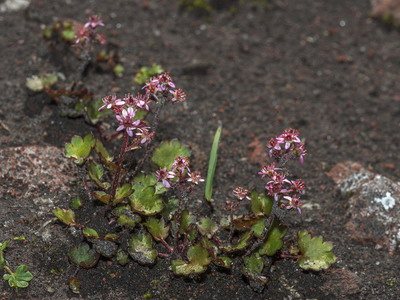

The plant will grow in the highlands, on rocks, talus, so it feels great on depleted soils (on alpine hills and in mountain gardens).
Panicle saxifraga
This type of plant is distinguished by a complex root system and creeping leaves, which can grow from the root itself and form voluminous rosettes.
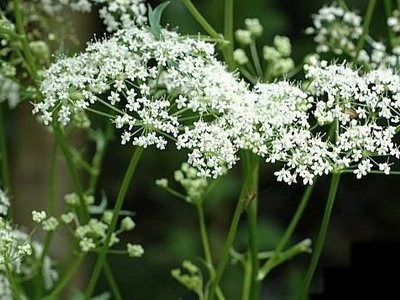

The leaves of the thigh saxifrage are leathery, fleshy, rounded, with a velvety surface pleasant to the touch. There is a grayish bloom on the leaves of this plant, since it is able to release lime on the surface of the leaves.
The thigh saxifrage, the photo of which is presented below, begins to bloom at the end of spring:
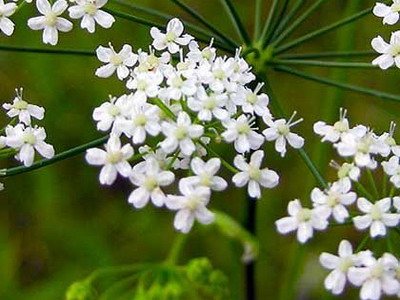

The flowering period begins in the last days of May and lasts until the end of August. Flowers can be white, crimson, pink and yellow. The flower has five petals collected in a paniculate or umbellate inflorescence. At the end of the flowering period of the saxifrage paniculata femur (approximately in September), the plant develops a capsule fruit containing a lot of seeds.
Saxifrage (saxifraga) it is cold-resistant, used for decorating rocky hills and borders along with other perennial flowering crops. Great for planting in dense shade in moist, well-drained soils. Combines with black currant, elderberry, edible honeysuckle.
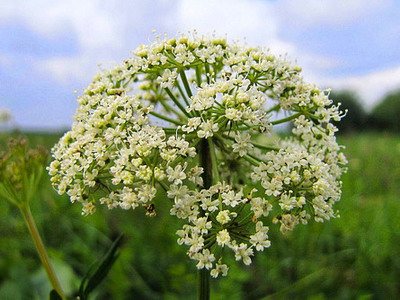

Saxifrage: growth pattern
The leaves of the saxifrage form a rosette, as a result of which the plant is a ground cover. The filamentous stolons of the plant hang over the edges of their pot.
The height of the leaves of this plant usually does not exceed 8 cm. In summer, long peduncles covered with hairs appear from the center of the rosette. The height of each of them can be almost half a meter. Inflorescences of light small flowers are located on them.
Indoor saxifrage: photo
Wicker saxifrage
In the south of Russia, saxifrage (Saxifraga stolonifera) is grown in gardens, but in the middle lane it is cultivated as a houseplant. This species is quite unpretentious. It has rounded green leaves with radial light stripes. The leaf blades are covered with hairs.
Wicker saxifrage
Forms a rosette, from which numerous layering depart, forming young rosettes at the ends. The plant is usually placed in a hanging planter, from which shoots with rosettes at the ends hang.
Saxifrage: care features
In order for the saxifrage to always retain its attractive appearance at home, it is necessary to regularly remove yellowing leaves and stolons from it. The most suitable soil for her is a mixture of sand, turf and humus in a 1: 1: 2 ratio. Usually, adult plants grow in the house for a couple of years, after which a young saxifrage is grown from the shoots.
In the summer, watering the plant should be abundant, but the soil should have time to dry out. In winter, watering should be moderate. It is recommended to water very carefully, not allowing water to get on the leaves - this leads to the formation of brown spots on them. Nutrients must be added twice in each spring and summer month.
For saxifrage leaves to always have an attractive pattern, the plant must be under diffused lighting. Direct sunlight can cause burns on the leaves. The optimum temperature in the warm season is about 20 degrees, in winter it is slightly more than 10 degrees.
Saxifrage cortusoliferous
Saxifraga cortusifolia has white flowers that bloom in September-October. Plant height 20-30 cm.
Saxifrage kortuzolistny, grade ‘Rubrifolia’. Photo from appeltern.nl
The 'Rubrifolia' cultivar is reminiscent of Heuchera with its attractive leaves on bright petioles. The leaf blades are glossy and beautifully dissected, olive green above, crimson below. In autumn, the plant is covered with delicate openwork inflorescences, consisting of white flowers on crimson peduncles.
Saxifrage shadow
Shadow saxifrage (Saxifraga umbrosa), another name for urban (Saxifraga x urbium). Named for its ability to grow in shaded areas. Forms a continuous carpet no higher than 10-15 cm. Evergreen spatulate leaves have denticles along the edge, interesting variegated forms are bred. Blooms in May-June.
Saxifrage shady ‘Variegatum’. Photo from the site kvetki-gorki.by Plants of the ‘Aureopunctata’ variety have green leaves decorated with yellow spots, their rosettes are no more than 10 cm in diameter. Pink flowers with a purple center rise on high (up to 40 cm) peduncles. Blossoming in May-June.
Compatibility in landscape design
A low-growing flower is often used in landscape design in a variety of combinations.... Its excellent ability to survive and grow in the poorest soils allows you to refine and tidy up the most unfavorable parts of the garden. It is enough to sprinkle the rocky areas with a thin layer of garden soil and plant a couple of saxifrage bushes there, in a couple of years there will be a dense carpet of lush greenery and variegated small flowers.


Alpine slide
In addition to single plantations, saxifrage is actively used for ridges and alpine hills, the bole looks especially impressive with undersized flowering specimens. The ideal option would be irises, phlox, tiarella.
As borders, saxifrage is combined with purslane, but this neighborhood will not last long, purslane must be constantly sown.
Large saxifrage tubs are very popular., in winter they are admired in closed rooms, only the temperature is selected appropriately.
Care during and after flowering
During the period of ejection of inflorescences, it is useful to feed, increase the amount of potassium and phosphorus. Loosening, timely watering is also required. Faded buds are removed from the bush. If the florist plans to collect seeds, then you need to wait for the ripening of the fruit-box, from which the planting material is taken out, dried, put into paper bags for storage.
After flowering, you need to take care of the formation of new leaf plates. The aboveground part is cut to stimulate the growing season in the new season. The plant hibernates in the ground, but shelter from a large number of fallen leaves and spruce branches is required.
Alpine snow saxifrage
The frost-resistant plant, the snow-alpine saxifrage, is very popular.
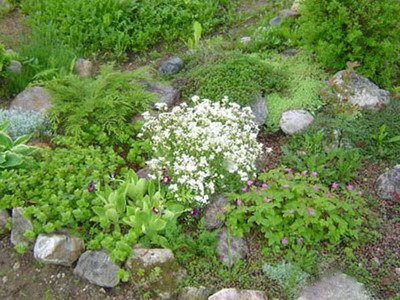

It is a groundcover perennial that looks perfect between other plants and on an alpine slide.
The plant reaches a height of 20 cm and forms a dense deciduous carpet, which is covered in spring with large star-shaped flowers of white color and creates a real "snow" carpet underfoot. Therefore, it is also often called the alpine saxifrage, which thrives in humid and cold climates.
This plant looks good in combination with other low-growing plants, for example, with low irises and sedums. Loves partial shade, although it can grow in the sun.
1. Seven Secrets of Success:
| 1. Growing temperature: the saxifrage does not like intense heat and even during the growing season the air temperature should be 18 - 20 degrees Celsius. For most varieties, there is a dormant period during the winter months, which the plants must spend at a temperature of 5 to 10 degrees Celsius. |
| 2. Lighting: in the morning and evening hours, the saxifrage can take sun baths for 1 - 3 hours daily. During the day, plants should be protected from sun exposure. |
| 3. Watering and humidity: In spring and summer, watering should be abundant, with listening to the soil surface to a depth of 3-4 cm. In autumn and winter, watering, especially when kept in cool conditions, is reduced to a minimum. Air humidity is increased only when the air temperature exceeds 18 degrees Celsius. |
| 4. Pruning: saxifrage needs regular sanitary pruning, when dead rosettes, peduncles with fading buds and individual yellowed leaves are removed. |
| 5. Priming: Different varieties and saxifrage require different soil pH levels. Plants are most often undemanding to the content of nutrients in the substrate, but they prefer soils with excellent drainage. |
| 6. Top dressing: from spring to autumn, the flower is fed monthly with fertilizers for succulent plants. In the fall, top dressing is reduced to naught and resumed only in the spring, with the appearance of small leaves or new outlets. |
| 7. Reproduction: saxifrages reproduce by sowing seeds after preliminary stratification, separation of daughter rosettes, air layering, some varieties are able to reproduce by stem cuttings. |
Botanical name: Saxifraga.
Saxifrage flower - family... Saxifrage.
Where grows... The homeland of the plant is Asia.
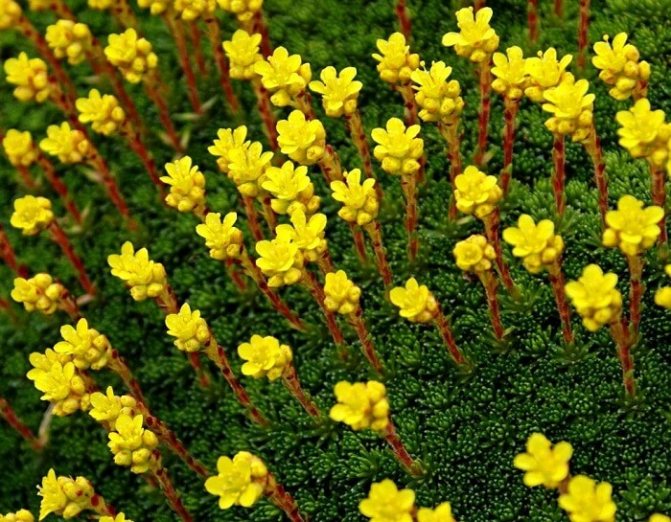

Description... Saxifrage is a large genus consisting of many evergreen, semi-evergreen or deciduous, perennial, biennial, less often annual plants.
Saxifrage - miniature plants that form rosettes of small, rounded leaves up to 5 cm in diameter. The leaves are mostly light green, sometimes with fine silvery veins and purple underside.
Peduncles are high - up to 45 cm, sometimes branched, appear from the center of the leaf rosette, bear at the top many white, pink star-shaped flowers up to 3 cm in diameter.
This ornamental plant often forms creeping shoots with miniature daughter rosettes.
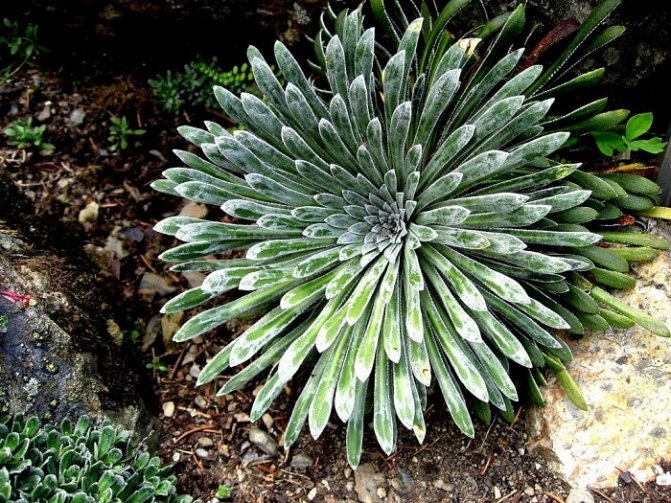

Height... Saxifrage grows rather slowly and rarely exceeds 5 - 8 cm.
Growing in the garden
Saxifrage planting material can be used within 3 years after purchase or collection. However, stratification must be performed before sowing. The seeds should be placed in soil mixed with a little sand. Refrigerated stratification should take 2 months.
Your task is to grow seedlings. After the specified time, it will be necessary to remove the seeds and place them in a fertile soil mixture. Let me remind you that it should be:
- clean;
- easy;
- fertile.
I recommend mixing regular soil with sand. Before sowing a flower, it is necessary to decontaminate the soil mixture. Just pour boiling water over it. Plant the seeds without burying them deeply, spray the soil with a spray bottle.
After a couple of weeks, you will see borings, and after another 2 weeks, several stronger leaves. You will need to perform a pick. I recommend replanting the saxifrage in small peat pots.
In order for the flower to grow well in open ground, you need to periodically temper it. In late spring, take your seedlings outside. Plant the seedlings outdoors in early June. The first year the saxifrage will grow greenery, and in the summer, the next year, it will form flowers.
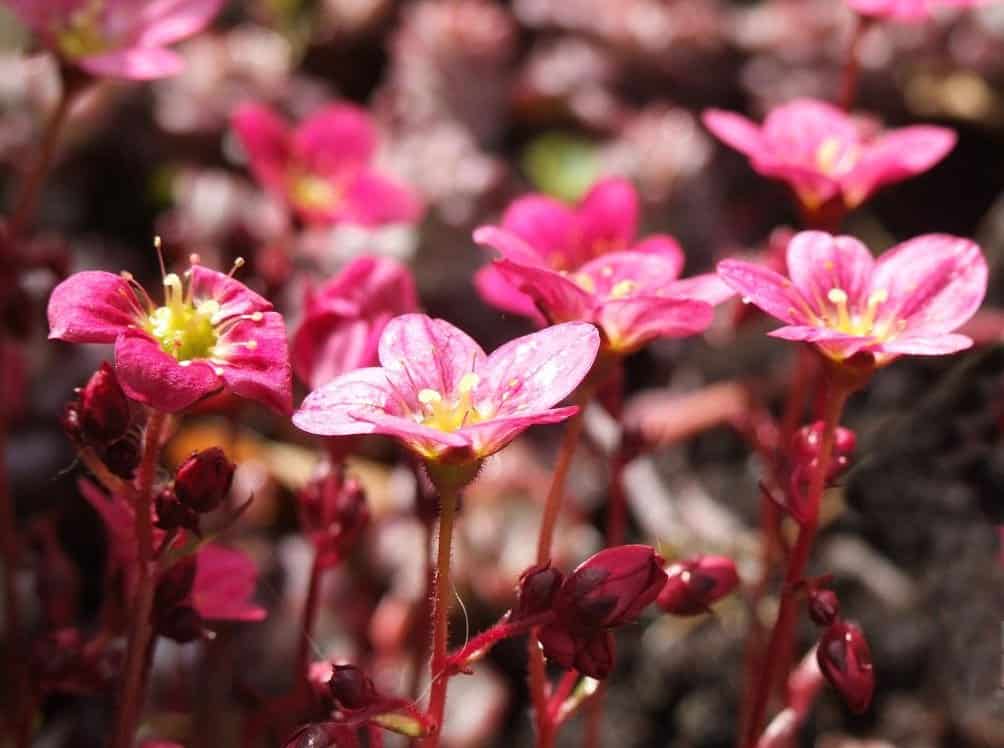

Growing from seeds
- Seeds are planted in mid-spring.
- A light soil (peat mixture), slightly moistened, is prepared.
- The pot is filled with a little earth.
- The seeds are poured out onto the surface and stored in a cold place or in a refrigerator.
- It is not necessary to sprinkle them with earth, just press lightly with your palm.
- After three weeks, the pot is sent to a room with a temperature of 18 degrees. For example, on the windowsill.
- It should be covered with foil to create a greenhouse effect.
- The first shoots appear in 7 days.
- The appearance of the first true leaves will be a signal for a dive.
- Peat pots are being prepared, where seedlings will be transplanted.
- Watering is carried out from a spray bottle.
Garden decoration
Saxifrags look attractive in rocky compositions, such as alpine slides, rockeries, all kinds of retaining walls. The plant looks great in tandem with:
- phlox (creeping);
- undersized bells;
- dwarf irises;
- gentian.
Also, the culture will harmoniously fit into a rocky garden. Shade-loving varieties are perfect for planting in the shade of trees, bushes, buildings or fences
Suitable care
Saxifrage is a rather unpretentious plant, as it grows in the wild in harsh environmental conditions, but there are some subtleties:
- The plant needs diffused sunlight, windows on the west side or the east are ideal. In direct sunlight, the saxifrage loses its decorative effect. The northern side is not suitable only for varieties with variegated colors, they need more sunlight.
- In winter, the saxifrage needs rest at an air temperature of 12 to 15 degrees, the rest of the time the comfort temperature should be 20 - 25 degrees.
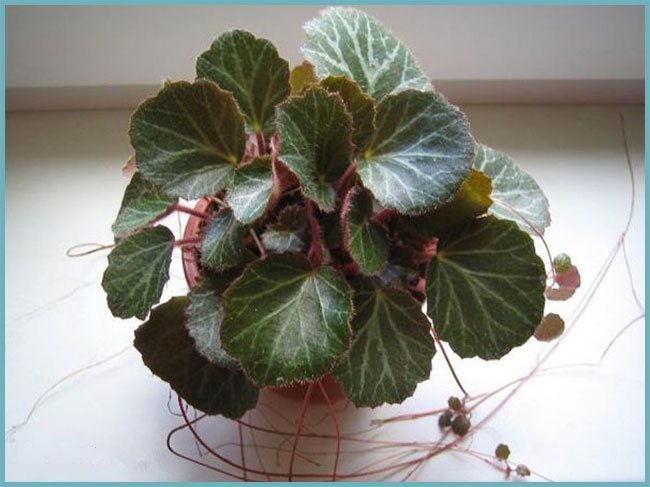

The plant will feel good on the windowsill, where there is a lot of light. - Water the plant year-round as the soil dries, less often in winter. Waterlogging is not allowed, as it leads to various rot.
- If it is not possible to fence off the saxifrage from the streams of hot air that rises from the heating batteries, then spray the plant more often. The same applies to hot summers, when the air temperature exceeds 25 degrees.
- When the roots of the saxifrage cover the entire earthen lump, it is necessary to transplant the plant into a more spacious pot.It is advisable to do this in the spring.
- In summer, the plant can be taken out onto the balcony. Do not forget about shading and protection from precipitation.
- Every few days it is necessary to clean the foliage of the plant from dust. To do this, it is enough to spray the saxifrage with warm water. Do not wipe the leaves so as not to damage them.
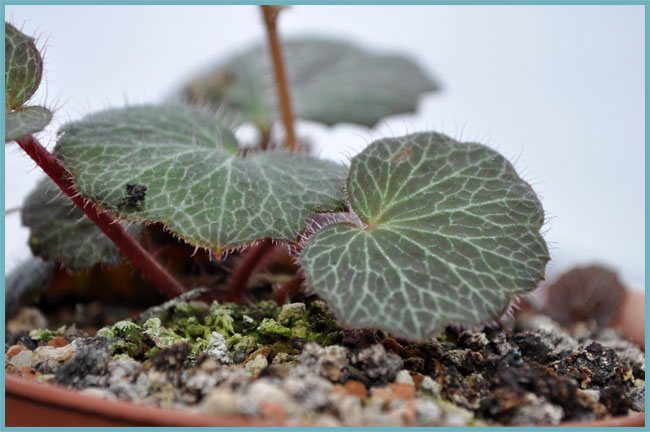

Plant in a small, low ceramic pot
Flamingo Saxifrage, Purple Robe and Pink Carpet
The types and varieties of saxifrage, the photos of which can be viewed below, are very diverse and colorful:
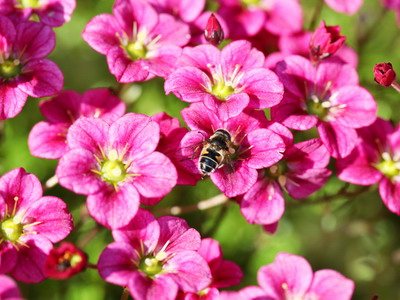

There are many varieties on the market that can survive in all conditions. The most popular mixtures and hybrids of this family are the crops below.
Flamingo Saxifrage - a blooming culture that forms a bright carpet of many small flowers. Blooms continuously for 1.0-1.5 months. Propagated by sowing seeds for seedlings.
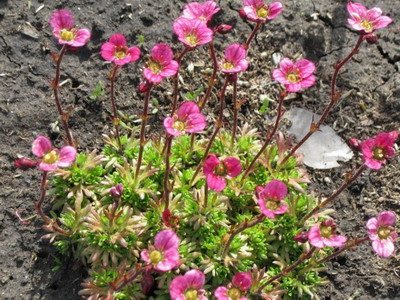

Saxifrage Purple Mantle - a plant up to 15 cm high, does not need special care and gives flower growers a minimum of problems, therefore it is widespread everywhere. Such a flower will definitely take its rightful place in any flower arrangement and on a rocky hill.
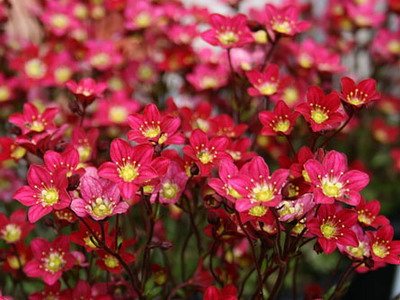

Saxifrage Pink carpet - frost-resistant ground cover perennial flower. It looks perfect on an alpine slide. The plant reaches a height of up to 20cm. The flowers of the pink saxifrage are large, star-shaped, creating a dense carpet.
Cesium saxifrage or salivary (Saxifraga caesia)
Sisolist saxifrage is a herbaceous perennial ornamental culture with a thin rhizome, forming thick turf from branching shoots. Its habitat is limestone rocks. Flowers are white with erect ascending peduncles. Cesium saxifrage blooms in July-August. Requires careful care and proper attention.
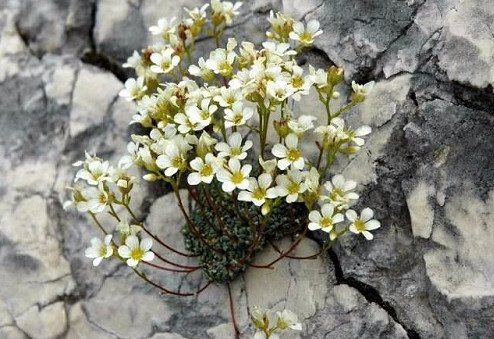

Mulching, loosening
Moisture stagnation is a problem against which the roots and leaves of saxifrage rot. It is useful to periodically loosen the soil around ground cover plants. Adequate aeration has a positive effect on the growth of any flowers, including saxifrage.
Mulching is an effective method of retaining moisture. Interestingly, medium-sized stones are often used to cover the soil near the plants. Weeds practically do not grow under the dense cover. Before forming a layer of mulch, be sure to moisten the substrate.
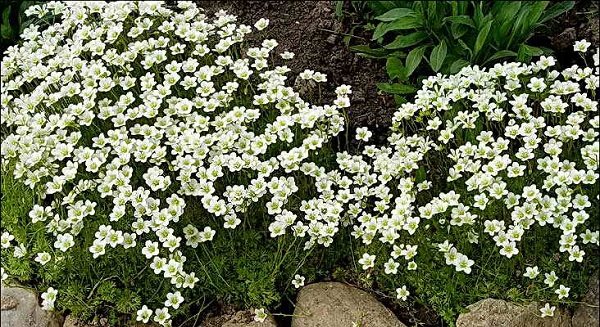

Wintering
Autumn care must be observed before the onset of cold weather. The plant must be cut almost to the root: it is important that the movement of juices practically stops for the winter period.
A perennial plant tolerates cold well, but without shelter, the saxifrage freezes out. Fallen leaves and spruce branches are used to create a protective layer. A thick layer of natural materials reliably protects the decorative look from frost.
Before wintering, the rosettes are necessarily cut off: the aerial part of the plant of the minimum size should remain.
Possible growing problems
Despite the unpretentiousness of the saxifrage, some growers complain about it, they say that it is "not found" with them, they cannot breed, bald spots appear in the turf, the bushes die. The reason is most likely in the root system, which is as compact as the aboveground part. It dries up in dry periods without watering and, conversely, rots on damp and never dry soils.
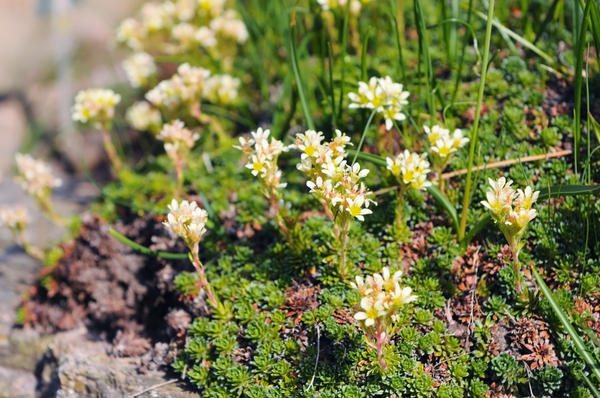

The photo shows the dead rosettes of the saxifrage
By the way, root rot is the most common disease of saxifrage. If you notice that the bushes fall out precisely because of it (rot), then dig up the surviving ones and transplant them to a more favorable place: better illuminated by the sun and without stagnant water.
The saxifrage also has enemies among insects. Aphids sometimes settle on the leaves, and in especially dry years, spider mites. For insect pests, use insecticides (Spark, Inta-Vir, etc.), for ticks, use acaricides (Actellik, Antimite, etc.).Or you can take a broad-spectrum drug that simultaneously kills insects and ticks - insectoacaricide (Fufanon, Karbaphos, etc.). Do not poison saxifrage during flowering to avoid poisoning pollinating insects.

